|
Men and women bearing the Porteous name are known to have pursued occupations from herdsmen to heralds, blacksmiths to bishops, millers to missionaries. Possibly not all may have distinguished themselves as did Captain Pat Porteous, but all will have worn their name with pride.
Below we honour just a few, from various walks of life and callings, who lived in different parts of the world – the famous and the not-so-famous....
James "Dunty" Porteous the miller (c 1650)
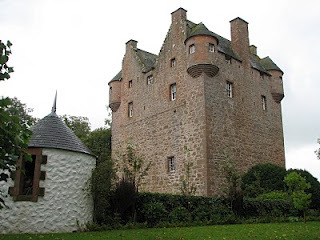
The strangest tale concerning a member of the Porteous family is that of the miller, James Porteous. Arrested for allegedly setting fire to his mill, Porteous was confined in the dungeon of Spedlin's Tower by Sir Alexander Jardine, Lord of Applegirth. The story goes that Sir Alexander was called away to Edinburgh, taking with him the key to the iron door of the dungeon. As time went on, the miller realised that he was trapped, and he cried out, wailing continually that he was dying of hunger. When Jardine arived in Edinburgh, remembering the prisoner he had left behind, he despatched a courier back to Applegirth with the key. However, it was too late, and as the thick iron door was opened, it was discovered that Porteous had died of hunger, having first gnawed off his own hand.
The legend is told by the Jardine family that the ghost of "Dunty" Porteous haunts Spedlin's Tower to this very day. The family are said to have moved out of their stronghold to a more spacious residence across the river at Jardine Hall, "partly the escape the hauntings of Porteous".
Captain John Porteous and the Edinburgh Riots (d 1736)
The well-known story of the so-called Porteous Riots is mentioned by Sir Walter Scott in The Heart of Midlothian. As Captain of the City Guard of Edinburgh, Captain John Porteous was charged with keeping the peace and when, in April 1736, two convicted smugglers were due to be publicly hanged, the public outcry was such that the hangman had to be placed in protective custody. As the situation worsened, for fear of an attempt to rescue the victims, the Lord Provost of Edinburgh instructed Captain Porteous to call out the entire guard and to furnish them with powder and shot.
After the execution the mob became violent, and Captain Porteous instructed his men to fire into the crowd, killing three people and wounding twelve others. For this offence, Porteous himself was eventually tried in the High Court of Justiciary and found guilty of murder and sentenced to death. Although later granted a Royal Pardon, Captain Porteous was dragged out to be cruelly tortured and lynched himself at the hands of an angry mob. The spot where he died is marked by a memorial plate in the Grassmarket.
It has been suggested by Buchan that John Porteous could have born into a branch of the Hawkshaw Porteous family, but this seems to be pure conjecture.
A more detailed biography of Captain Porteous and account of the events leading up to his death can be found on the Captain Porteous page on this website.
Rt Rev Beilby Porteus, DD, Bishop of Chester and London (1731–1809)
Beilby Porteus was the son of Robert Porteus, a native of Virginia, US who had returned to England in 1720. Educated at York and Ripon, he was a classics scholar at Cambridge University and was ordained as a priest in 1757. Appointed Chaplain to the King in 1769, Beilby Porteus became Bishop of Chester in 1776 and subsequently was appointed Bishop of London in 1787.

As Bishop of Chester, Beilby Porteus became known as a noted abolitionist – taking part in many debates in the House of Lords, where he vigorously opposed the slave trade. He was responsible for missions to the West Indies, as well as to India, and published volumes of sermons and tracts.
Renowned as a scholar and a popular preacher, it was in 1783 that the young bishop was to preach his most famous and influential sermon, a well-reasoned and much-reprinted plea for 'The Civilisation, Improvement and Conversion of the Negroe Slaves in the British West-India Islands Recommended', before the Society for the Propagation of the Gospel in Foreign Parts.
One of many Porteous/Porteus family members who were churchmen, Beilby was a supporter of many in the evangelical wing of the church. A friend of Hannah More and of William Wilberforce, the abolitionist, Beilby himself took a deep interest in the plight of West Indian negro slaves, preaching and campaigning actively against the slave trade. He was active in the establishment of Sunday Schools in every parish, an early patron of the Church Missionary Society and one of the founder members of the British and Foreign Bible Society.
A more detailed biography of Dr Porteus can be found on the next page of this website.
John Porteous, New World trader (1766–87)
As emigration to the New World increased in the middle of the eighteenth century, there was a corresponding growth in trade, especially in the provinces bordering the St Lawrence River. When, in 1868, control of the Indian trade in Quebec was transferred to independent traders, John Porteous, partner with his cousin John Duncan and James Phyn in the company of Phyn, Ellice and Porteous, managed the company's business in Detroit and Michilimackinac, importing rum and tobacco. As the volume of trade increased rapidly, John Porteous supplied the British garrisons in New York and Philadelphia with goods shipped from England. He later formed his own business, intially a trading venture out of Boston, Massachusetts and later out of Charleston, South Carolina and St Augustine, Florida, shipping goods such as indigo, tobacco and rice back to London.
Gladstone Porteous, missionary to China (1874–1944)
Born in 1874 of Scottish parents, Gladstone Porteous was accepted for missionary service with the China Inland Mission in 1904. A fervent evangelical Christian, Gladstone worked amongst tribal groups in Kweichow, Szechwan and East Yunnan provinces of China, translating parts of the Bible into three different Chinese dialects. Well loved by the people amongst whom he worked, Gladstone Porteous also translated Bible stories and Christian teaching in verse, compiled a hymn book and established a strong self-supporting church for the Tibeto-Burman Nosu people of Yunnan. When he died there of typhus in 1944, a large polished stone slab was placed in his memory, with the inscription in English, Nosu and Chinese, and erected by local Christians.
Stanley David Porteus, psychologist and author (1883–1972)
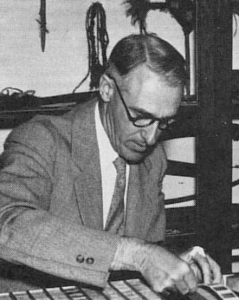
Stanley Porteus was born in 1883 at Box Hill, Victoria, Australia, educated in Melbourne, New South Wales and, after graduation, served as Schools Superintendent of special schools in Melbourne. Having established a clinic for children with behavioural problems and realising the inadequacy of the psychological tests available in the early years of the twentieth century, he devised new tests of his own, specifically to establish the subject's initiative and purpose. The most well-known of these, the Porteus Maze Test, a non-verbal intelligence test, is still in use today. In 1916 Stanley Porteus joined the staff of the University of Melbourne as lecturer in Experimental Education and in 1918 was invited to join the Vineland Training School in New Jersey, USA, moving there to become Director of Research. In 1922 he moved to Hawaii where he founded the Psychological and Psychopathic Clinic at the University of Hawaii, eventually becoming its director.
The author of many papers and books, Porteus also made a study of the intelligence of Australian aborigines and African bushmen. His theories about the superiority of intelligence of white races has led to recent controversy, including protests by students at the University of Hawaii. He died in 1972 at Honolulu, where a University Building was named after him.
|
|
Captain Pat Porteous VC, Royal Artillery (1918–2000)
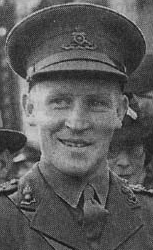
Captain Pat Porteous was awarded the Victoria Cross, Britain's highest military honour, first instituted by Queen Victoria in 1856, for his part in the 1942 assault on Dieppe in the Second World War. Attached to No 4 Commando unit, he was liaison officer between two detachments who were charged with attacking the heavy coastal defence guns. Despite being shot through the hand, Captain Porteous saved the life of a British army sergeant by disarming and killing a German soldier. When the attack seemed doomed to failure, with two officers killed and the Troop Sergeant Major seriously wounded, in the face of heavy fire and despite being himself wounded a second time, Porteous dashed across open ground to take command, leading his men to finally take the position.
In spite of severe wounds, Pat Porteous went on to make a full recovery and had a distinguished military career in Palestine, Germany and Singapore, rising to the rank of Colonel before he retired in 1970. He had the honour of being in the leading car at the late Queen Mother's 100th Birthday Parade, before his death in August 2000. An obituary notice can be found on the Victoria Cross website.
Henry Porteous, East India Company (1815–19)
When, in 1815, Napoleon Bonaparte was exiled to St Helena, he landed from HMS 'Northumberland', accompanied by a troop of soldiers with fixed bayonets - for fear of trouble from the crowd of curious onlookers. He was to lodge at the house of Mr Henry Porteous, Superintendent of Improvements with the East India Company at Jamestown, and was greeted by Mr Porteous on his arrival. When he arrived, Naploleon was accorded every courtesy. Unfortunately, suffering from a terror of assassination, he would not go to bed until a strong bolt had been fitted on the door of his bedroom and two valets stationed to sleep on mattresses outside the door. Napoleon clearly did not enjoy his stay at Jamestown, for the next day he moved to The Briars, home of Mr William Balcombe, where he slept in the summer house - and where he stayed for the next two months. He died on St Helena in 1821.
The Porteous family had been resident on the island of St Helena since 1787, but the family left shortly after the death of Henry Porteous in 1819, at the age of 57.
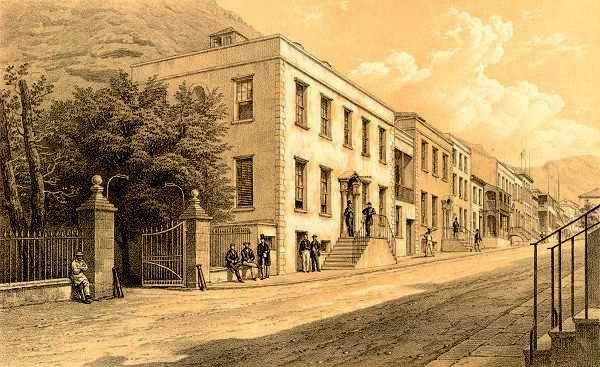
A quote from the website of the East India Company recalls a fascinating coincidence relating to Napoleon and the Duke of Wellington:
"History records an interesting quirk of fate. Like many of their contemporaries, the Wellesleys visited the Company's island of St Helena in the South Atlantic. When Arthur, future Duke of Wellington, was returning from the East to fight the battle of Waterloo, he stopped over on St Helena and spent the night at the guest house of Mr Porteus (sic) in Jamestown. Exactly one year later Napoleon spent his first night of exile in the same room. In some obscure corner of the Company empire, the two most powerful men in the history of that time shared one everyday experience. Wellington, hearing of this coincidence after Napoleon's defeat, wrote to Admiral Malcolm on St Helena from the deposed Emperor's capital.
'You may tell 'Bony' that I find his apartments at the Elysée Bourbon very convenient, and that I hope he likes mine (in St Helena)... It is a droll sequel; enough to the affairs of Europe that we should change places of residence.'"
Robert Richard Porteous, Lance-corporal, US Marine Corps (1946–67)
The only Porteous name recorded on the Vietnam Veteran's Memorial Wall in Washington, DC is that of Robert Richard Porteous, Lance-corporal, 'H' Co., 2nd Batt., 4th Regt., 3rd Marine Div., US Marine Corps (1946–67), killed in action by small arms fire at Quang Nam, near Phu Bai, South Vietnam on February 5, 1967. His body was recovered and returned to his family. Eldest son of George and Katherine Porteous of Indianapolis, he was known as 'Bob' to his family, who were devastated at his loss. Originally intending to enlist in the US Navy, he joined the US Marines instead, where he was later earmarked as a candidate for Officer Candidate School. He was 6'5", a sportsman, who especially liked fly fishing and tinkering with auto engines.
I am indebted to Peyton H. Ford, uncle of R.R. Porteous for this information.
This researcher would be interested to hear of any further information about Robert Richard Porteous, whose home city was Indianapolis, Indiana. Please contact the webmaster at The Porteous Research Project.
Emma Caffin Jeffery Porteous, pioneer in Canada (1830)
The daughter of an English general medical practitioner in Chichester, Sussex, Emma Jeffery always had a taste for adventure. Wanting to see the world, she applied for and accepted a position in the service of Mr and Mrs McTavish with the Hudson's Bay Company in Canada. Arriving in Montréal, the party travelled the nine miles to Lachine, where they stayed at the Governor's mansion, and then set out by canoe the 1500 miles to the northwest, taking a route up the Ottawa River around Lake Huron and Lake Superior, negotiating nine miles of rapids, eventually arriving in Moose Jaw – having made history as the first group of women ever to make the journey by canoe. Emma Jeffery later married Nichol Porteous and died in 1880, having survived two husbands. She had made her home in and was buried in Montréal.
James Porteous, inventor (1848–1922)
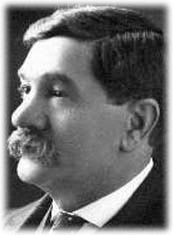
A 25-year-old Scot named James Porteous asked a ticket agent for passage to America in 1873. "Where do you want to go?" asked the agent. "I have no idea," replied Porteous. "This family here just bought a ticket to Santa Barbara," said the agent. "Why don't you travel with them?" So Porteous did.
That may be anecdote, but it does help us understand Porteous. By 1877 he was selling wagons in Fresno, California. By 1880 he was an American citizen who had been woven into Fresno Valley farm life. Valley agriculture depended upon irrigation. That meant canal digging. Fresno farmers badly needed better earth-moving equipment for their sandy soil. Farmers experimented with horse-drawn earth-mover designs. The problem was harder to solve than it seemed.
Yet Porteous solved it. His series of patents reveal a subtle thread of real inventive genius. Fresno farmers had been using something called a buck scraper to move earth. It scraped up dirt and pushed it along in front. It was hard to pull and hard to unload. Porteous' C-shaped scraper had a blade along the bottom. It scooped dirt as it was pulled along. That much was like the buck scraper, but this machine rode on runners and could be tilted. An operator walking behind it could change the angle. When it was full, he tilted it back and let it glide on the runners. He could dump dirt as he passed over low spots and smooth out terrain. He could vary the angle of attack to match the soil.
Porteous called it the "Fresno Scraper," and he formed the Fresno Agricultural Works to build it. It was soon being used all over the world. It was one of the most important agricultural and civil engineering machines ever made. Fresno Scrapers served the US army in World War I. The two-horse model retailed for $28, yet today's bulldozer blades are its direct offspring. The gigantic scraper-carryall earth mover is its grandchild.
Finally, at the age of 47, Porteous raised eyebrows in Fresno by eloping with a long-standing lady friend named Jenny Ritchie. No matter. He raised children and piled up inventions until he died at the age of 74. In his maturity, Porteous drank in the new 20th century. He owned Fresno's first car. He took up photography. He told his six children about the airplane he'd once invented. What's behind that story, we never find out. His last house is now a Boy Scout Headquarters. Finally, when he died, his family found that he'd left behind a book of poetry. I suppose that's no surprise from a man who'd taken such active delight in shaping America.
(by John H Lienhard, first broadcast in the radio series 'The Engines of Our Ingenuity', reproduced with permission)
The Fresno Scraper is being designated by the American Society of Mechanical Engineers History and Heritage Committee as an International Landmark. It is featured prominently in the Fresno Metropolitan Museum.
|

![]()


